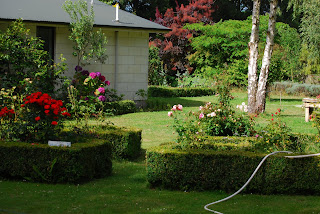 One good way to save money, and if you if you like to make money, is by using existing plants in the garden by layering or taking cuttings. We have done this with a variety of plants and it is especially worthwhile for expensive plants like Rhododendrons. Sally wanted box (Buxus Sempervirens) hedging as a border around various plots in the garden but to buy the smallest plants from the nursery was going to cost too much so she set about taking cuttings with great success as you can see from the photograph in the foreground and background. All you need is a little patience and nature will do the rest.
One good way to save money, and if you if you like to make money, is by using existing plants in the garden by layering or taking cuttings. We have done this with a variety of plants and it is especially worthwhile for expensive plants like Rhododendrons. Sally wanted box (Buxus Sempervirens) hedging as a border around various plots in the garden but to buy the smallest plants from the nursery was going to cost too much so she set about taking cuttings with great success as you can see from the photograph in the foreground and background. All you need is a little patience and nature will do the rest.Get a tray or some sort of container that is about 10-15 cms deep and fill it with sand (coarser than finer) and thoroughly wet the sand. The size of the tray is up to you and depends on how many cuttings you want to take but don't make it too big because wet sand is heavy and so if you need to shift the tray at planting time make sure you can!
 It is best to take cuttings in early summer, November in New Zealand, and use the fresh growth at the tips of the plants. Cut off about 10-15 cms of plant with sharp secateurs or pruners or whatever you call them, remove about 4-5cms of the foliage from the bottom of the cutting, again with sharp thingys (you need to have clean cuts when ever you remove things so there is as little damage to the stem as possible) and then push the defoliated end into the sand up to the first leaves.
It is best to take cuttings in early summer, November in New Zealand, and use the fresh growth at the tips of the plants. Cut off about 10-15 cms of plant with sharp secateurs or pruners or whatever you call them, remove about 4-5cms of the foliage from the bottom of the cutting, again with sharp thingys (you need to have clean cuts when ever you remove things so there is as little damage to the stem as possible) and then push the defoliated end into the sand up to the first leaves. The sand must be kept damp all the time and the tray kept in the shade, we put the trays under trees for the shade but if you ain't got any trees (yet) then use a 50-75% shade cloth. The cuttings should not be exposed to sunlight.
The sand must be kept damp all the time and the tray kept in the shade, we put the trays under trees for the shade but if you ain't got any trees (yet) then use a 50-75% shade cloth. The cuttings should not be exposed to sunlight.Now naturally not all the cuttings will take, and some will stay green for ages but there will be no root development. We generally take 25 -50% more cuttings than we plan to use and this allows for those that don't root as well as those that don't survive after transplanting. It's great to have too many to use but it is very frustrating to not have enough! Anyway, anyway bag them up any left over and keep them as replacements or for selling on next season or whenever - they don't cost much just sitting there.
Layering Rhododendrons is pretty straight forward but you need established plants with long enough lower branches so that they can readily be dug into the ground surface. So get an inner, lower branch stem where there are no leaves - remove some leaves if you have to, but you will need a few at the end of the branch - and place this stem 5cms into the earth, cover it with soil, and pin it there so it can't move. Then..... well be patient.
Apparently some plants are better than others but we have had a lot of success - remember patience.



No comments:
Post a Comment